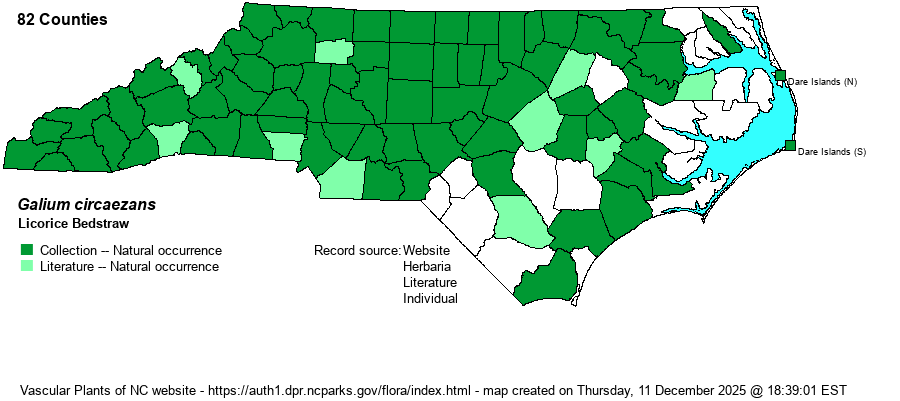| Author | Michaux | |
| Distribution | Present over the Mountains, Piedmont, and the western two-thirds of the Coastal Plain; seemingly very rare to absent in the eastern portions, though it does occur in a few maritime forests on the Dare County Outer Banks.
This is a widespread species in the East, being found in most counties from ME and southeastern SD south to the FL Panhandle and central TX. | |
| Abundance | Common in the Mountains and Piedmont; locally fairly common to infrequent in the western and central Coastal Plain, but scarce in the Sandhills region. Mostly absent in the far eastern counties, except present in a few maritime forests. | |
| Habitat | This is a species of shaded habitats -- essentially in rich to mesic hardwood and mixed forests. It is scarce in bottomlands, and it does not occur in sandy or dry soils. |
| Phenology | Blooms from April to June, and fruits shortly after flowering. | |
| Identification | This is a familiar hardwood forest species, with somewhat erect to leaning stems, rarely trailing; it grows to about 1 foot tall or long. It has mainly smooth stems and leaves, with leaves in whorls of 4. The leaves are fairly wide, being ovate to elliptical, about 1-inch long and 1/2-inch wide; the tips are acute. Broken leaves smell like licorice. The small greenish-white flowers are mainly in terminal clusters or from upper axils, generally in elongated clusters with widely scattered flowers. The montane G. lanceolatum has white flowers, but that species has longer leaves to about 1.5-2 inches long, and they are lanceolate in shape, widest near the base instead of near the middle in G. circaezans. Another montane species -- G. latifolium -- also has long and lanceolate leaves, but it has purple flowers and smooth but dry fruit. G. pilosum also has 4 leaves per whorl, but it has quite hairy stems and tends to be more branched and with longer stems. That species has more branched flower clusters, with each white flower on a pedicel; P. circaezans has sessile flowers on a long flowering stalk. | |
| Taxonomic Comments | None, though many references list varieties for the species.
| |
| Other Common Name(s) | Forest Bedstraw, Wild White Licorice | |
| State Rank | S5 | |
| Global Rank | G5 | |
| State Status | | |
| US Status | | |
| USACE-agcp | FACU link |
| USACE-emp | UPL link |

